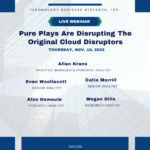SAP and SoftwareONE: Persistent value through pragmatic transformation
After TBR published a special report on SoftwareONE’s place in the software, cloud and IT services ecosystem, we spoke with Pierre-Francis Grillet, SoftwareONE’s global director of SAP Business Development, to learn more about how his firm’s SAP practice competes in an exceptionally crowded market.
Three key points stood out to TBR:
- SoftwareONE’s focus on its core strengths including expertise in SAP, cloud and licensing, which are all crucial in the move to cloud and Everything as a Service, fits well with current trends in the IT services, cloud and software landscape.
- Emphasizing pragmatic, incremental transformation over broad digital transformations helps SoftwareONE more easily define its value to clients.
- Grillet and his team understand which cloud platform works best in a client’s environment, and they’re willing to make recommendations, differentiating SoftwareONE from vendors seeking to be multicloud agnostic.
Given SAP’s massive on-premises ERP install-base — which totaled 25,000 customers as recently as 1Q22 — the market opportunity surrounding migrations from offerings like SAP ERP Central Component (ECC) to SAP Business Suite 4 HANA (S/4HANA) is vast. As such, my colleague Evan Woollacott notes that S/4HANA is critical to SAP’s ability to achieve its midterm ambition of more than €22 billion in non-IFRS cloud revenue out of more than €36 billion in non-IFRS total revenue by 2025.
This goal would bring SAP’s mix of cloud revenue as a percentage of total revenue to over 60% in 2025, compared to a mix of approximately 41% based off SAP’s 2Q22 earnings. Given SAP’s 2Q22 S/4HANA Cloud revenue was just $503 million across 14,500 live clients, the company has a long way to go to achieve its goal. From a services partner perspective, such as SoftwareONE, SAP’s need to accelerate migrations to S/4HANA represents a substantial revenue opportunity, particularly given the inherent complexity associated with these transformations.
While it’s true that SoftwareONE will constantly be competing against larger players with scale and smaller players with lower prices, if it persists with a smart, well-refined and well-executed strategy that stays true to the company’s core strengths, it should continue to grow ahead of peers.
GSI fatigue opens opportunity lanes for SoftwareONE
According to Grillet, clients have grown tired of global systems integrators (GSIs) with massive teams based in low-cost countries doing things cheaply because they can. Instead, clients looking for SAP implementations welcome the chance to work with smaller vendors bringing expertise-led approaches and IP-rich capabilities.
While the giant GSIs adequately serve the largest enterprise-scale clients, SoftwareONE has found a sweet spot with the high end of the SMB market and low end of enterprise-scale customers, particularly those overlooked by the global GSIs. With a go-to-market focus and capabilities tool kit aligned around lifting and shifting SAP applications to the cloud and technical upgrades to S/4HANA, SoftwareONE stays industry agnostic while leveraging well-honed software asset management skills and an acquisition strategy that brings in boutique and highly specialized firms.
In short, if customers don’t want the hassle of working with a giant IT services vendor but do want SAP experts with experience, SoftwareONE looks like a pretty good choice.
Don’t overthink baby steps
From high-level strategy consultancies to thin-margin VARs, vendors constantly hype their abilities to help enterprises unlock the value of digital transformation. Grillet and SoftwareONE have a refreshingly modest and believable counterproposal: pragmatic, incremental IT and business transformation, with the sober recognition that a change as significant as migrating to S/4HANA and to the cloud needs to be executed in a series of manageable — and financially feasible — steps.
In Grillet’s opinion, “S/4 touches everything,” so overcoming hurdles like resilience, security, and interoperability and connectedness should be approached with caution, expertise and realistic expectations. Pragmatic, incremental transformation may not sound as exciting as design thinking-led agile disruptive innovation, but software that doesn’t work is useless, no matter how transformative it could be.
“Whenever we are selecting the service provider partner, it has to be the long-term journey, not just to go by project-based or portfolio-based services. But if you want to do innovation gently and new value with more outcome results, we really want to see and we have to make [the service provider] a longtime partner.”
— Executive Director, Banking
“I think it’s really based on whether they [vendors] take on responsibility. When I’m looking for something, I look for people I trust to work with, and I don’t like it to be sold.It doesn’t matter whether they’re technology vendors or whether they are consultant vendors. So usually, the technology vendors have a better grasp of what our real problem is when we were looking for a solution. I think consultants in the real sense of consultants are usually hired when the board wants to make sure there’s something that they sort of have a grip on it or more control.”
— Chief Digital Officer, Insurance
Multicloud agnosticism means not knowing what works best
When advising clients on which cloud environment to choose for migrating applications or even a full-on instance of S/4HANA, Grillet said SoftwareONE does not shy away from making specific recommendations, eschewing the industry habit of staying multicloud agnostic. Grillet believes his team has the expertise and experience to evaluate a client’s technology needs and long-term strategy, then recommend the cloud environment that fits best, without regard to SoftwareONE’s alliance relationships with or revenue targets aligned to the three hyperscalers.
SoftwareONE cannot claim uniqueness in its aversion to multicloud agnosticism, but the company is definitely among the trendsetters in the broader consulting, IT services, software and cloud space moving toward a greater willingness to partner deeply to better serve specific clients rather than broadly try to please all clients.
Small and smart
SoftwareONE’s SAP practice includes 440 professionals working in 34 countries, performing cloud migrations, S/4HANA conversions and S/4HANA implementations. While not at the scale of the SAP giants, such as Accenture, Atos and EY, that TBR covers quarterly, TBR sees SoftwareONE as smartly leveraging its strengths, including 14-plus years of delivering pragmatic, incremental migrations that help clients with successful transformations.
Further, SoftwareONE stays within its lane, expanding its footprint at existing clients and slowly expanding its scope of services without pretending to be industry or functional specialists, a strategy TBR believes will generate steady revenue growth, loyal clients and consistent permission to compete.
As noted in TBR’s latest Cloud Ecosystem Market Landscape, vendors across the entire digital transformation spectrum “often like to position themselves as end-to-end providers. Many do indeed offer a comprehensive stack of offerings, but the ‘ends’ largely vary and revolve around each vendor’s core value proposition. While enabling and/or developing components of the IT stack provides a strong use case, vendors’ true value lies in their ability to manage partner ecosystems.” Staying in one’s swim lane and partnering smartly lie at the core of SoftwareONE’s strategy, boding well for sustained growth.
“I would probably be sacrificing some technical expertise on the problem solving in order to get internal alignment or buy-in from others who have relationships with that firm. At the same time, those firms [consultancies] are outrageously expensive. So, you have to balance fewer but more important pieces of work versus, you know, the ability to afford help on more projects.”
— SVP, Retail


 Technology Business Research, Inc.
Technology Business Research, Inc.